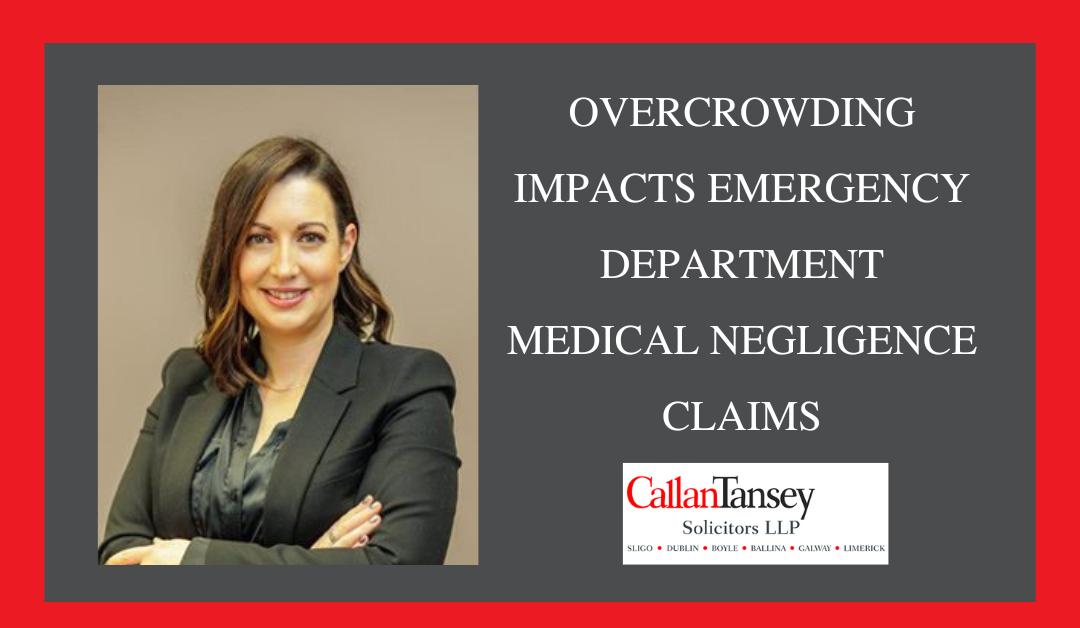The staff at hospital Accident and Emergency Departments provide vital and valuable services to the entire community. However, Emergency Department Medical Negligence claims account for almost 15% of all Medical Negligence claims. The most recent studies have shown a 50% increase in the number of reported ‘clinical incidents’ in emergency medicine over a four year period. Overcrowding in Emergency Departments lengthens waiting times and means staff work in increasingly difficult conditions. Here we examine how this can lead to Emergency Department Medical Negligence claims.
How does Emergency Department Medical Negligence arise?
Emergency department medical negligence claims can arise in the following ways:
- Failure to recognise an acute condition e.g., appendicitis, meningitis, evolving stroke;
- Premature discharge, transfer or step-down from an acute hospital setting;
- Failure to adequately note, record or review a patient’s pertinent medical history;
- Failure to access timely investigative imaging e.g., MRI/CT/Ultrasound/X-ray.
- Discharging a patient without the appropriate referral and/or safety netting advice regarding their health or in the event of potential deterioration.
Delayed Diagnosis or Delayed Treatment
More than 1.5 million patients attend Emergency Departments annually, with record numbers attending in 2022. The seasonal rise in the numbers attending Emergency Departments over the winter presents additional challenges to an already stretched healthcare system. Delays in ambulance response times, triage, diagnostic testing and initial diagnosis all lead to delayed treatment. This delay in providing treatment can cause further illness, deterioration in the patient’s condition, poorer outcomes and even death.
The Emergency Medicine Programme for Ireland recommended an advisory target that 95% of patients should be either admitted or discharged within a 6-hour window of arrival at the ED.
The 2021 National Inpatient Experience Survey conducted by HIQA reported that of a cohort of 7239 presentations to A&E, 5135 (71%) said they waited more than the recommended 6 hours before being admitted. Of those, 305 people reported waiting more than 48 hours before they were admitted.
Even before the effects of the COVID-19 pandemic were felt by our A&E Departments the 2019 National Inpatient Experience Survey found that 70% of people reported being admitted to a ward within the target waiting time of 6 hours and 4% of over 8000 patients report they were waiting 48 hours or more before admission to a ward for appropriate treatment.
Misdiagnosis in the Emergency Department
Emergency Department Misdiagnosis is not uncommon. Patients present in often busy, overcrowded conditions to medical staff with a high workload. Overcrowding, delay and misdiagnosis are inextricably linked. Studies have shown that misdiagnosis can occur in 1 in every 9 patients admitted through the Emergency Department.
A 2021 analysis conducted by the UK Royal College of Emergency Medicine concluded that 4519 excess deaths were directly as a result of overcrowding and delays of 12 hours or longer. Adjusting these figures to reflect the population of Ireland (5 million v 68 million), 316 people a year could be dying in this country because of overcrowding, delay and misdiagnosis.
Misdiagnosis can also have severe medical implications, including the development of secondary conditions which have the obvious effect of exacerbating conditions and increasing hospital stays which lead to poorer patient outcomes.
Failure to Diagnose Acute or Underlying Conditions
When patients present at an Emergency Department they are often unable to provide clear information regarding their injury or illness. Many may be distressed or disorientated and unable to give a complete medical history.
In addition, some acute conditions require critical and prioritised care such as major trauma, acute coronary events, embolisms, an evolving stroke, meningitis, appendicitis and cauda equina syndrome. Often however the failure to appreciate these critical, time sensitive conditions arises from the fact that the patient isn’t triaged properly or medically assessed in an appropriate time frame by a Doctor.
Failure to order or carry out diagnostic tests and scans
The failure to diagnose conditions is often as a result of the failure to order the appropriate investigative imaging in time or at all. This issue is often felt more acutely at the weekends and on public holidays when other imaging facilities, which patients may be sent to as alternatives, are closed. These include x-rays, MRI, CT scans and ultrasounds.
Poor follow up advice
It is essential that safety netting advice is offered to patients on discharge in the event that their condition worsens or deteriorates. The failure to offer this advice leaves the patient, who is already in a vulnerable condition, unaware of the need to re-attend when certain symptoms are felt.
LISTEN BACK: Interview on The Pat Kenny Show on Newstalk. Interview starts at 1 hour 34 minutes.
Making a claim for Accident and Emergency Medical Negligence
If you believe that you have experienced inadequate medical care in and Accident and Emergency department you may be entitled to make a claim for medical negligence.
How do I make an Accident and Emergency Medical Negligence Claim?
You have two years from the date the negligence occurred, or the date that you discovered that the effect of the injury was not treated properly, because of medical negligence, to start court proceedings, with some exceptions:
- Where a child has been injured as a result of negligence, court proceedings can be commenced any time before their 20th birthday.
- There are no time limits to make a claim on behalf of someone who lacks the mental capacity to take their own case.
While it may be the case that you have months or even years to commence court proceedings, it is strongly advised that you engage a solicitor to investigate the injuries arising from potential negligence in the A&E Department you or a loved one visited. This will enable us to gather medical evidence such as hospital records and expert reports in support of your claim.
If you have any questions about the issues raised in this article you can contact our Medical Negligence team.


